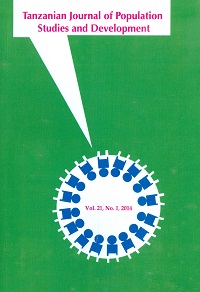Sustainability of Pastoral Livelihoods in Roadside Settlements in Tanzania: A case of Vigwaza and Dakawa villages
Abstract
Drawing from a sample of two roadside settlements in Tanzania, this paper examines the sustainability of pastoral livelihoods in these locations. It notes that in recent decades the centuries-old balance between pastoral systems and nature has become unviable due to gradual erosion of access to land and water. In addition, changes in lifestyles, coupled with the impact of education, economic pressure, environment and social interaction between pastoral and non-pastoral communities, have all contributed to the changes in the pastoral ways of life. In response to this, pastoralists are increasingly diversifying their livelihoods both within their traditional homelands and in distant areas. This diversification has necessitated changes in pastoralists ' settlement patterns. One such a change has been the migration into roadside settlements where, in addition to livestock-keeping, they also engage in non-pastoral activities. Findings reveal that migrant pastoralists have maintained their tendency to rebuild the livestock herds, and with increased number of livestock, environmental degradation, though at the moment localized, poses a threat to the sustainability of their livelihoods. Therefore, although pastoral livelihoods have been diversified, in the long run they are far from being sustainable. This is largely due to the threat that increased livestock pose to the environment, and some policy failures to address the problems of the pastoralists in general.
References
Alan, W. 1965. The African Husbandman. Edinburgh: Oliver & Boyd.
Ashley C. & D. Carney. 1999. Sustainable Livelihoods: Lessons From Early Experience
Ashley C. 2000. The Impacts of Tourism on Rural Livelihoods: Namibia ' s Experience. Overseas Development Institute, Working Paper 128
Ashley C., & K. Hussein. 2000. Developing Methodologies for Livelihood Impact Assessment: Experience of the African Wildlife Foundation in East Africa. Overseas Development Institute, Working Paper 129
Beall, J. 2002. Living in the present, investing in the future: household security among the urban poor. In C. Rakodi, & T. Lloyd (Eds.) Urban Livelihoods: A people-centred approach to reducing poverty. London: Earthscan.
Behnke, R.H. 1994. Natural Resource Management in Pastoral Africa. Development Policy Review, 12: 5 €“27.
Behnke, R.H., & I. Scoones. 1993. Rethinking Range Ecology: Implications for Rangeland Management in Africa, IIED & Overseas Development Institute, London.
Blaikie, P. 1988. The Explanation of Land Degradation in Nepal. In: J. Ives and D.C. Pitt (Eds.). Deforestation: Social Dynamics Watersheds and Mountain Ecosystems. London: Routledge.
Blench, R. 2001. Pastoralism in the New Millennium. Rome: Food and Agriculture Organization.
Bryceson, D. 1999. African Rural Labour, Income Diversification & Livelihood Approaches: A Long-term Development Perspective. Review of African Political Economy 26, 80: 171- 189.
Chambers, R., & G.R. Conway. 1992. Sustainable Rural Livelihoods: Practical Concepts for the 21st Century. Institute of Development Studies Discussion Paper, 296.Cambridge.
Fabusoro, E. 2006. Key Issues in Livelihoods Security of Migrant Fulani Pastoralists: Empirical Evidence from Southwest Nigeria.
Farrington, J., Carney, D., Ashley, C. and Turton, C. 1999. Sustainable livelihoods in Practice: Early Applications of Concepts in Rural Areas. Natural Resource Perspectives No. 42. London: Overseas Development Institute.
Faugier, J., & M. Sargeant. 1997. Sampling hard to reach populations. Journal of Advanced Nursing, Vol. 26: 790-797.
Fratkin, E., M.E.R. Nathan. 2006. Is Settling Good for Pastoralists? The Effects of Pastoral Sedentarization on Children ' s Nutrition, Growth and Health among Rendille and Ariaal of Marsabit District, Northern Kenya: Presentation for Pastoralism and Poverty Reduction in East Africa: A Policy Research Conference 27-28 June 2006
Galvin, K., D.L. Coppock, & P.W. Leslie. 1994. Diet, Nutrition, and the Pastoral Strategy. In A.G. Hill (ed.). Population, Health and Nutrition in the Sahel. Rutledge & Kegan Paul
Sustainable Livelihoods Guidance Sheets Framework http://www.livelihoods.org/info /guidance_sheets_pdfs/sect8glo.pdf)
Macqueen, D. 2001. Measurement malaise: Is the SL Approach Inoperable? Mimeo.
Manger, L. 2000. East African Pastoralism and Underdevelopment: An Introduction. In L. Manger & A.G.M. Ahmed (Eds). Pastoralists and Environment: Experiences from the Greater Horn of Africa. Proceedings of the Regional Workshops on African Drylands, Addis Ababa and Jinja. Addis Ababa: OSSREA, 2000.
Mattee A.Z., & M. Shem. 2006. Ambivalence and Contradiction: A Review of the Policy Environment in Tanzania in Relation to Pastoralism. Issue paper No. 140 Ereto II Ngorongoro Pastoralist Project, Ngorongoro €“ Tanzania.
Nicol, A. 2000. Adopting a Sustainable Livelihoods Approach to Water Projects: Implications for Policy and Practice. Working Paper 133. London: Overseas Development Institute.
Nori, M. 2007. Mobile Livelihoods, Patchy Resources and Shifting Rights: Approaching Pastoral Territories. Working Discussion Paper, International Land Coalition
Scoones, I. (ed.). 1995. Living with Uncertainty - New Directions in Pastoral Development. London: IT Publications.
Turton, C. 2000. The Sustainable Livelihoods Approach and Programme Development in Cambodia. Working Paper 130, London: Overseas Development Institute.
United Republic of Tanzania (URT). 1981. 1978 Population Census Vol. II. Dar es Salaam: Government Printer.
€”. 2005. 2002 Population and Housing Census: Village and Street Statistics €“ Morogoro Region, Vol. VII, Tanzania.
Vogt, W. P. 1999. Dictionary of Statistics and Methodology: A Nontechnical Guide for the Social Sciences. London: Sage.


